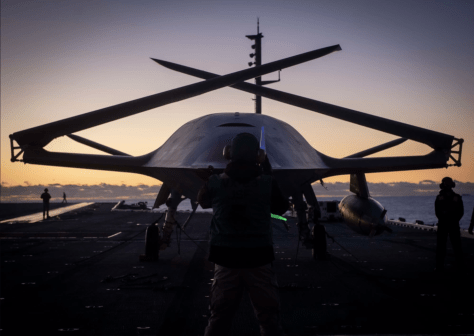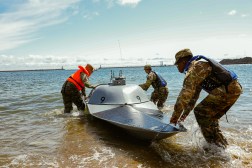Navy issues new RFI for large unmanned surface vessel

Naval Sea Systems Command issued a sources-sought notice for a robo-ship initiative that is a centerpiece of the service’s plans to field lethal, uncrewed vessels at sea as part of a “hybrid fleet” of manned and unmanned systems.
The RFI for the Large Unmanned Surface Vessel (LUSV) was posted Nov. 3 on Sam.gov on behalf of the Unmanned Maritime Systems Program Office (PMS 406), under Program Executive Office Unmanned and Small Combatants, which is developing requirements for the detail design and construction of the ship.
“LUSV will support Distributed Maritime Operations (DMO) and provide the Joint Force with an adjunct missile magazine capability and capacity. Primary missions include the support of Anti-Surface Warfare (SUW) and Strike Warfare (STW),” according to the notice. “LUSV is a high-endurance, affordable asset capable of weeks-long deployments and trans-oceanic transits. LUSV will be built to commercial American Bureau of Shipping (ABS) vice military standards. As an adjunct magazine, LUSV will operate with Carrier Strike Groups (CSG), Expeditionary Strike Groups (ESG), Surface Action Groups (SAG), and individual manned combatants.”
The Navy is putting forth a set of technical questions and asking for industry’s feedback on the ship specification draft. However, the full RFI contains controlled technical data. To view it, vendors must first request access to the “Bidder’s Library” where it’s been posted and complete a user agreement form. Contractors must also be cleared to view Department of Defense Distribution D materials.
Responses to the RFI are due Dec. 4.
The sea service has already been experimenting with robo-ship prototypes. Four USVs sailed across the Pacific Ocean this summer — mostly autonomously, with little help from humans — via the U.S. Navy’s Integrated Battle Problem 23.2 exercise, including the large-sized Mariner and Ranger and medium-sized Sea Hunter and Sea Hawk.
It has also been testing the ability of unmanned vessels to launch weapons. In 2021, the Department of Defense posted a video of a Ranger launching an SM-6 missile. Last month, the Navy’s Task Force 59 used a MARTAC T38 Devil Ray USV, equipped with a Lethal Miniature Aerial Missile System, to fire at a target boat during the Digital Talon exercise in the Middle East region.
The Navy requested $117.4 million in advanced technology development funding for the LUSV program in fiscal 2024, but Congress hasn’t yet passed a full-year appropriations bill for defense and federal agencies are operating under a continuing resolution. The service received $136.6 million in advanced technology development funding for LUSV in fiscal 2023, according to budget documents.
According to a recent report from the Congressional Research Service, the Navy envisions LUSVs as being 200 feet to 300 feet in length and having full load displacements of 1,000 tons to 2,000 tons — about the size of a corvette.
“The Navy wants LUSVs to be low-cost, high-endurance, reconfigurable ships with ample capacity for carrying various modular payloads—particularly anti-surface warfare (ASuW) and strike payloads, meaning principally anti-ship and land-attack missiles. Each LUSV could be equipped with a vertical launch system (VLS) with 16 to 32 missile-launching tubes,” per the study.
The Navy’s 2024 budget request indicated that it wants to procure the first LUSV in 2025 at a cost of $315.0 million, another two in 2026 at a combined cost of $522.5 million, three of them in 2027 at a combined cost of $722.7 million, and three more in 2028 at a combined cost of $737.2 million, according to the CRS report.
Earlier this year, then PEO for unmanned and small combatants Rear Adm. Casey Moton, said the concept of operations for these types of systems will be “fully compliant” with the Pentagon’s autonomous weapons policy, indicating that a human will be making the decision to launch weapons from a robo-ship.
“The LUSV ConOps is not intended to be [fully] autonomous. It is engage-on-remote just like we already do in our Aegis [destroyer] fleet. The only difference is the human that’s actually making the engage decision is sitting on a platform other than the USV,” he said during remarks at the Surface Navy Association’s annual symposium.
For last month’s weapons launch from the uncrewed MARTAC T38 Devil Ray USV during the Digital Talon exercise, the Navy noted a human operator at Task Force 59’s Robotics Operations Center ashore was in the loop and gave the green light to attack the target.






